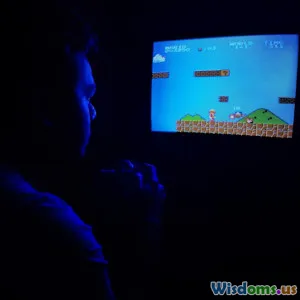
Indie Games and Community Building
8 min read Explore how indie games foster thriving communities through creativity, engagement, and unique player experiences. (0 Reviews)
Indie Games and Community Building: Crafting Worlds Beyond Gameplay
In the dynamic sphere of gaming, indie titles have emerged not just as sources of entertainment but as catalysts for vibrant community building. Unlike blockbuster game studios, indie developers often harness tightly-knit player communities to grow and sustain their projects. These communities evolve into much more than fan groups—they become collaborative ecosystems where players and creators coalesce, innovate, and celebrate their shared love of gaming.
This exploration delves into how indie games cultivate community, the mutual benefits, and the transformational impact on the gaming landscape.
The Distinct Nature of Indie Games
Indie games, short for independent games, are typically developed by small teams or individuals without the financial support of large publishers. This constraint fosters innovation as these developers rely heavily on creativity, unique storytelling, and original mechanics to attract players.
Games like Undertale and Hollow Knight exemplify indie success stories—not just for their gameplay but because of the passionate communities they inspired. Unlike commercially-driven AAA titles, indie games often emphasize player interaction, transparency, and community involvement from the outset.
Why Community Matters for Indie Games
Amplifying Reach through Word of Mouth
Indie developers lack the mammoth advertising budgets of large studios. Instead, player communities shape word-of-mouth buzz, organically driving the game's growth. Strong community engagement leads to active social media sharing, fan art creation, streaming, and even modding, which exponentially increases visibility.
For instance, Stardew Valley initially grew primarily through Twitch streamers and fan forums—players sharing tips, mods, and experiences magnified its popularity beyond traditional marketing.
Providing Direct Feedback Loops
Another critical advantage is the ability to iterate based on player feedback, often in near real-time. Unlike big studios with rigid production pipelines, indie developers can directly engage with their players through Discord servers, Reddit AMAs, or community updates.
David Rogers, creator of Slay the Spire, credits his active community for helping polish gameplay and add valued features: "Our players weren’t just testers—they became collaborators. That changed the entire development rhythm."
Cultivating a Shared Culture and Identity
The shared ownership fostered by community participation builds loyalty and trust. Players don’t just consume content—they shape the cultural identity of the game world. This can be seen in games like Celeste, where mental health themes encouraged heartfelt discussions and collective empathy within the community.
The phenomenon extends to organized fan events or digital gatherings where players bond over their mutual experiences, creating a unique space beyond the game itself.
Tools and Platforms Igniting Community Growth
Several digital platforms have become crucial venues for indie game community development:
- Discord: Real-time communication and channels for discussions, fan art, and support empower direct and personal connections.
- Steam Community: User reviews, forums, and workshop modding tools help players interact and modify the game experience.
- Reddit: Hosts focused subreddits where players debate strategies and share content.
- Patreon and Kickstarter: Crowdfunding not only provides financial backing but also a community invested in the game’s success.
Each platform plays a role in diversifying how players interact with developers and one another, fortifying the game's grassroots foundation.
Case Studies: Indie Games Thriving Through Community
Among Us — Cultivating Suspense and Social Interaction
Originally released in 2018 to modest attention, Among Us exploded in 2020 through Twitch and YouTube community streaming. The developers’ open stance on modding and community-created content helped the game stay fresh and engaging.
The community-driven nature of the gameplay—based on deception and teamwork—is enhanced by players sharing experiences online, further strengthening bonds and encouraging cooperation both in-game and socially.
Factorio — Player Empowerment Through Modding
Factorio’s intricate factory-building gameplay owes part of its cult status to extensive modding support. The active modding community contributes features, UI improvements, and new content, which the developers readily integrate.
This participatory approach leads to a cycle of innovation, with players gaining creative agency and developers benefiting from community-driven enhancements.
Celeste — Emotional Connection Through Community Storytelling
Celeste struck a chord with communities because of its exploration of mental health issues. Players shared stories, fan-made content, and supportive discussions around the game's themes.
This community engagement extended the game's impact beyond entertainment, offering solidarity and inspiration within and outside gaming circles.
Challenges Indie Developers Face
While community engagement yields remarkable benefits, it also imposes challenges:
- Community Management: Small teams may struggle with moderating forums and social channels effectively.
- Balancing Feedback: Catering to community demands without compromising the developer’s vision can be delicate.
- Toxicity Prevention: Ensuring the space remains inclusive and welcoming requires continuous effort.
Overcoming these challenges is vital to maintaining a healthy, sustainable relationship between developers and players.
The Future: Community as a Cornerstone of Indie Success
The trajectory of indie gaming points to an expanding role for community building. Emerging technologies like virtual reality and blockchain are poised to deepen player immersion and ownership.
Moreover, as game development tools become more accessible, prospective developers can launch their projects accompanied by organized community strategies from day one.
In educating developers on best practices of engagement and moderation, the industry can nurture thriving ecosystems where creativity and connection coalesce.
Conclusion
Indie games redefine the gaming paradigm by intertwining creative expression with community engagement. Beyond gameplay mechanics, they've built interactive, participatory worlds where players feel valued as co-creators and cultural contributors.
From grassroots marketing to feedback loops and emotional alliances, community building embodies the heart of indie game success. For players and developers alike, it offers an inspiring model of collaboration that transcends traditional gaming experiences, ensuring indie games remain vibrant and deeply impactful in the evolving entertainment landscape.
References:
- "The Impact of Player Communities on Indie Game Success" — Gamasutra
- Developer interviews from Slay the Spire and Stardew Valley official channels
- Twitch stream statistics on Among Us during 2020 surge
- Celeste community forums and thematic analyses
Rate the Post
User Reviews
Popular Posts


















